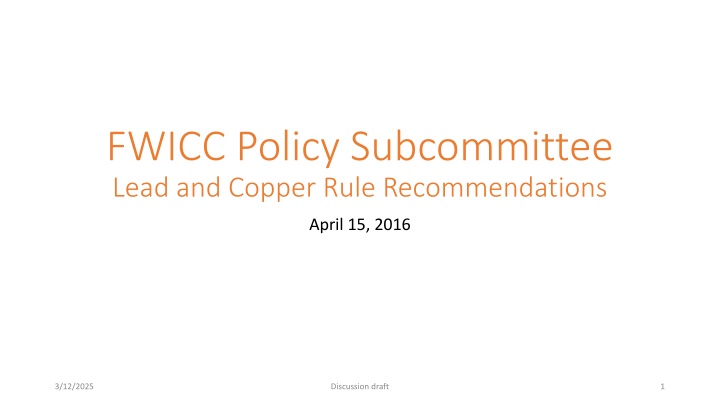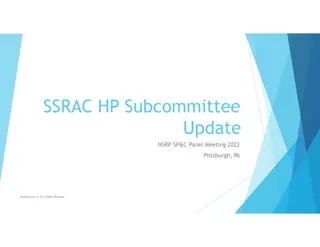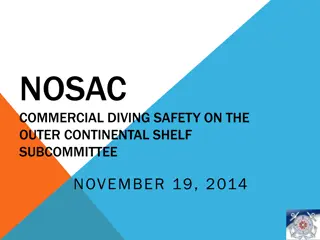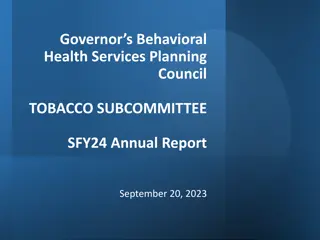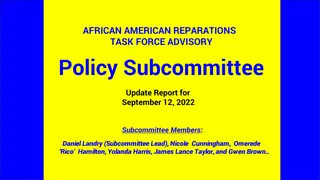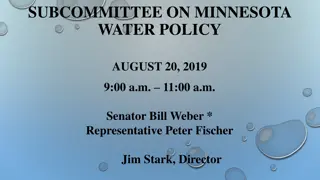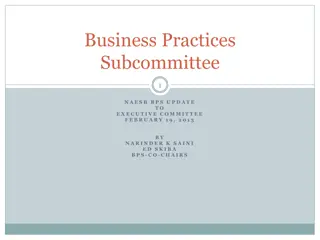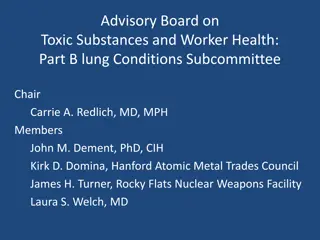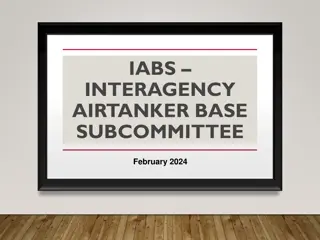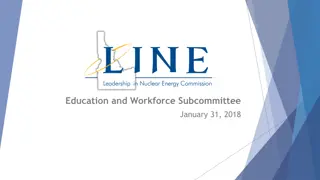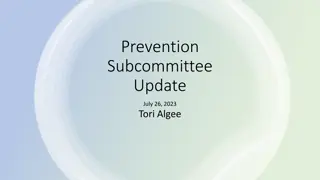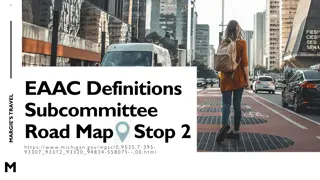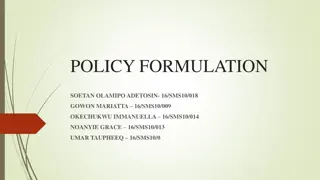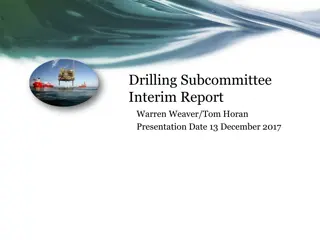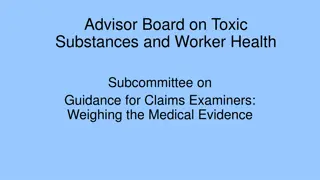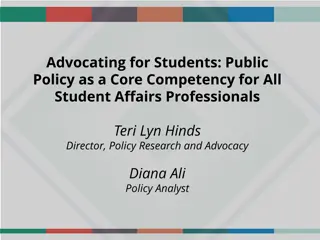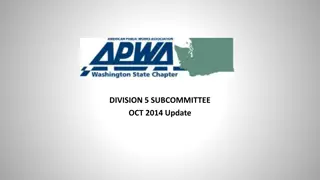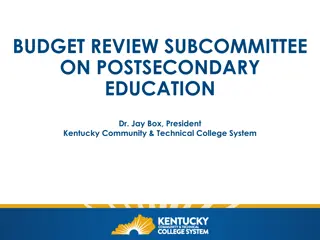FWICC Policy Subcommittee
Michigan's response to the water crisis in Flint has prompted a reevaluation of national water quality standards. This draft outlines the need for more stringent regulations to ensure safe drinking water for all Americans. It addresses the failures of the current federal lead and copper rule and proposes changes to protect public health.
Download Presentation

Please find below an Image/Link to download the presentation.
The content on the website is provided AS IS for your information and personal use only. It may not be sold, licensed, or shared on other websites without obtaining consent from the author.If you encounter any issues during the download, it is possible that the publisher has removed the file from their server.
You are allowed to download the files provided on this website for personal or commercial use, subject to the condition that they are used lawfully. All files are the property of their respective owners.
The content on the website is provided AS IS for your information and personal use only. It may not be sold, licensed, or shared on other websites without obtaining consent from the author.
E N D
Presentation Transcript
FWICC Policy Subcommittee Lead and Copper Rule Recommendations April 15, 2016 3/12/2025 Discussion draft 1
Lead and Copper Rules - Background As Michigan has worked to resolve this water crisis, it has become evident that what happened in Flint is not an isolated occurrence, and the rest of the nation needs to pay close attention to water quality standards. We have had red flags before from Washington, D.C. as far back as 2001, to Chicago in 2011, and to more recent cases in Philadelphia and Newark. The AP recently performed an analysis of ERA data and found that nearly 1,400 water systems serving 3.6 million Americans across the country exceeded the federal lead standard at least once between 2013 and 2015. The results are staggering. The water crisis in Flint has given the entire country a reason to re-evaluate the way we measure the safety of water for our children and families to drink. It s raised questions about how the federal lead and copper rule has been implemented. 3/12/2025 Discussion draft 2
Lead and Copper Rule FWICC Role By executive order, Governor Snyder created the FWICC to bring together a wide range of experts to work on long-term solutions to the Flint water crisis. Through close collaboration between state and local government, and subject matter experts, the focus of this subcommittee is to ensure safe drinking water for Flint and the entire state by having more stringent lead-level regulations than what federal rules require. 3/12/2025 Discussion draft 3
Current Federal LCR Issues Utility centric allows utilities to operate, promoting that they meet federal standards, which are not health based, and do not protect citizens. Shared responsibility model except most citizens don t know they were given this responsibility, assume utilities keep them safe. Fails to even address stated purpose minimization of lead in water at consumer taps. Per water industry, up to 70% of PWS with lead service lines would not pass action threshold with appropriate sampling. Leaves underlying problem doesn t replace lead pipes (or only replaces them partially), other lead-bearing plumbing, or other infrastructure damage (galvanized iron, etc.) that may be there for decades more. Disasters D.C., Flint, etc. History since 1991, multiple reform efforts have failed, leaving the public still vulnerable to disasters. 3/12/2025 Discussion draft 4
Changes Proposed - Overview Overarching Goal: To develop a national model that maximizes consumer protection and ensures transparency and public education at all times - thereby preventing additional water crises. Goal 1: Make the LCR Citizen Centric and make consumers informed participants in the LCR s shared responsibility model. Citizen Centric LCR oversight with public panels required at both the department and local level to ensure active public participation and awareness. Stringent notifications to assure prompt and accurate notice to impacted residents when the Lead Action Level is exceeded as well as robust public education on the risks and dangers of lead at all times. Require collaboratively developed robust public education programs. Goal 2: Achieve the stated purpose of the rule by minimizing lead in water at consumer taps. Elimination of gaps in sampling and testing protocols to assure that high risk homes are included and tested in transparent and scientifically valid methods. Goal 3: Remove the underlying problem. Aggressive lead pipe inventory and analysis requirement with remediation strategies that include a complete ban on partial lead pipe replacements and full system replacement. Goal 4: Enforce the rule. 3/12/2025 Discussion draft 5
Exceeding Federal Standards Goal 1: Citizen Centric - Oversight Creates a statewide Advisory Commission on Drinking Water Quality to assure citizen membership, input, and access. The new Commission will be charged with continuously assessing science, testing, monitoring protocols, and water treatment and corrosion control. The Commission will and provide advice and counsel to the Governor, the Legislature, and impacted state and local agencies on implementation of the act, areas for improvement, and best practices to optimize the protection and safety of drinking water. Requires the establishment of Water System Advisory Councils for each Public Water System (PWS) to assure citizen membership, input, and access, to oversee the enforcement of the LCR, to develop plans for community outreach and education, and to collaborate with community groups to assure correct implementation of the LCR. The Council will assure access to information regarding corrosion control, testing results, remediation processes, educational efforts and general water safety. Allows systems serving under 500 customers to utilize collaborative councils with other PWSs or delegate their responsibilities to the Advisory Commission. Require the Advisory Commission to lead annual training on lead in water, the health effects of lead, and the LCR. Training would be targeted toward federal, state, and local staff, and local Water System Advisory Councils. Training must include active participation and input from local community groups and representatives. 3/12/2025 Discussion draft 6
Exceeding Federal Standards Goal 1: Citizen Centric - Stringent Public Notifications Require lead disclosure statements on interior plumbing as a part of all home sales and all home rental contracts. Reduce Lead Customer Notice requirement for notice to individual customers that their test results exceed the LAL from 30 days to 2 business days. Where a PWS exceeds the LAL, the system will be required to complete a public system-wide notification within two business days and then complete a more in- depth public education in 30 days (the current requirement is 60 days). Expand the information required where a PWS exceeds the LAL. Where a PWS exceeds the LAL, require notices to all billed customers as well as public notices to all schools, community centers, and child care centers. Establish State Household Action Level of 40 ppb that requires strict notifications and access to blood lead testing. 3/12/2025 Discussion draft 7
Exceeding Federal Standards Goal 1: Citizen Centric - Robust Public Education Require delivery of robust public education campaign regardless of whether a PWS meets or exceeds the LAL. Based on the parameters adopted by the Advisory Commission on Drinking Water Quality, require each PWS to collaboratively develop a public education campaign with the local Water System Advisory Council on the dangers of lead and copper at all times. Require the public education campaign to include (1) specific information on the potential adverse health effects of lead contamination on infants, children, and fetuses, (2) the potential sources of lead, (3) the PWS compliance history on lead including most recent testing data, (4) the cost and availability of replacement fixtures, and (5) contact information for medical assistance. Require the public information campaign to include accurate and up-to-date information on the PWS system inventory. Require the public education campaign to be targeted to both the general population and any diverse population groups, including non-English speaking, within the PWS service area. Require the public education campaign to be delivered on a regular basis by multiple media including print, internet, and community and neighborhood forums. 3/12/2025 Discussion draft 8
Exceeding Federal Standards Goal 2: Achieve Stated Purpose of the Rule Lead Action Level: Phase in a reduction in the Lead Action Level from 15 ppb to 10 ppb by 2020 to align with the standards currently used by the World Health Organization. Corrosion Control Treatment: Require comprehensive lead and copper analysis prior to any significant change in water source or treatment by a PWS and require all CCT to be performed under the guidance of a licensed engineer and under the supervision of the Agency. Compliance: Eliminate mechanisms that permit PWSs to meet LCR requirements within water quality ranges and, instead, deem compliance to have occurred only when a Lead Action Level is met or approved corrective action is put in place. Additional, Supplemental Testing Requirements: Require annual testing of state facilities involving children and fragile adults including schools, day care facilities, nursing homes, health facilities, and adult foster care facilities. Facilities exceeding standards will be required to take remedial action. 3/12/2025 Discussion draft 9
Exceeding Federal Standards Goal 2: Achieve Stated Purpose of the Rule Sampling Remove current LCR gaps to ensure that testing and sampling captures worst-case lead in high risk homes. Require a phased in system inventory for all PWS including analysis of composition, estimated age, and length of system components. Require annual sampling eliminate variations currently afforded based on size and history of system. Remove exceptions for reduced sampling and define sample bottle size and require wide-mouth openings. Require state and local advisory council oversight of site sampling selection criteria. Require site sampling selection criteria to prioritize based on (1) length of lead service line, (2) homes with less water use than normal, (3) homes with higher water age, and (4) homes with galvanized iron after a lead pipe. Require two sample draws and specifically prohibit any diversion from specified protocol, including preflushing and aerator cleaning/removal prior to sampling. Require that annual sampling occurs in summer months unless alternate schedule is approved based on explicit knowledge that problems are worse in the PWS in other periods. 3/12/2025 Discussion draft 10
Exceeding Federal Standards Goal 3: Remove the Underlying Problem Prohibit partial lead service line replacements both during LCR remediation and during system maintenance. Require secondary notification to homeowners and neighbors during the replacement process to warn of physical disruption dangers. Require each PWS to adopt a full LSL replacement program within 10 years unless a longer period is specifically authorized by the Agency. Clarify the duty and ability of a PWS to replace lead service lines up to the resident s or business s meter. Prioritize replacement based on estimated length and age of service line, history of high lead water and high lead blood results, vulnerable populations, and where other distribution system improvements, such as water main replacements, provide opportunity for LSL replacement. 3/12/2025 Discussion draft 11
Exceeding Federal Standards Goal 4: Enforce the Rule Establishes state fines for violations of state rules to assure accountability and transparency. Clear and understandable fine parameters will be established based on the type of violation with automatic increased fine levels for repeat violations. Fine revenue will be deposited in the Drinking Water Revolving Fund. Require regulatory history including any fines imposed to be included in bold in all customer billings. 3/12/2025 Discussion draft 12
Current and Proposed Topic Current FWICC Policy Committee Proposed Action threshold 10% at/over 15 ppb Recommend reduction to 10 ppb by 2020. Sample selection criteria Residences with LSLs or lead plumbing Supplemental sampling of schools and public places involving children and fragile adults recommended for immediate annual testing. Sites with previous partial replacement testing, including galvanized iron connections to home, should be considered once inventory is completed. Sample size For large systems - 100 to 60; 60 to 30 Retain current sample size but permit no reductions. Include locations with elevated lead in bloods and samples from neighbors of over 15 ppb, but included those as supplemental samples only. Sample frequency Annual; Triennial; (every 9 years for small systems) Annual sampling without exceptions based on compliance history or system size. Sample draw First draw after at least 6 hour rest; no preflushing and aerator cleaning permitted Two draws required. No preflushing or aerator cleaning within a defined period prior to sampling. Bottle configuration specified with additional specificity on size and configuration of test sample bottles. No diversion of any sort permitted from sampling protocols. Sample site location Required to be based on worst case homes but gaps in that determination Sample site selection recommendations to be approved by state commission and local council. Systems required to provide documentation that targets homes meeting tiering conditions. In the sample site selection process, preference will be given to longer LSLs, homes with less water use than normal, homes with higher water age, and homes with galvanized iron after lead pipe. Action level required on high lead sample households None Establish a Household Action Level at 40 ppb requiring heightened notice and education, household water system diagnostics, and access to full blood lead testing for all residents. 3/12/2025 Discussion draft 13
Current and Proposed (Cont.) Topic Current FWICC Policy Committee Proposed Public education requirements With water bill; At risk groups; Press release Recommendations include two tiers (state and PWS specific) advisory council structure, heightened public education and notification requirements, and real estate disclosure forms. Requires robust public education campaign whenever a PWS meets or exceeds the LAL. Public education campaigns shall include targeting to fragile and hard to reach populations and shall include multiple media usage. Lead service line replacement Only when above action level; 7% per year; allows partial replacement Inventory and physical replacement plan required for all PWSs. No partial replacement. Clarification of control of lead service lines on private property required. Notification requirements must be strengthened and additional neighborhood and individual notifications should be mandated on the dangers of physical disruption. Database should be maintained of refused access into homes. Lead analysis (similar to radon testing) required for home sales. Water quality parameters In compliance by meeting parameters Decouple. Corrosion control Optimize with extended time period for sampling and implementation Increased specificity on CCT optimization, CCT analysis required within set time parameters when PWS shifts water source. Evaluation and adjustment of CCT must take into account all the factors in a given system that could contribute to high lead release. Complete transparency required on every requirement of rule. Citizen oversight Not required Two-tier approach with Advisory Commission on Drinking Water Quality required on the state level and each PWS required to have a Water System Advisory Council. PWS inventory Not required Regardless of LAL adherence status, each PWS will be required to complete a full system inventory including details on all parts and materials used. Required notifications Expand content and targets of notification requirements. Include neighbors and community centers in notice requirements. Reduce Lead Customer Notice period from 30 days to 2 business days. Enforcement Tied to federal penalty scheme Separate state fine and enforcement system built around unique state requirements. Fines tiered based on offense and doubled for multiple offenses. Mandatory notification to customers in bills and separate outreach for certain violations. 3/12/2025 Discussion draft 14
